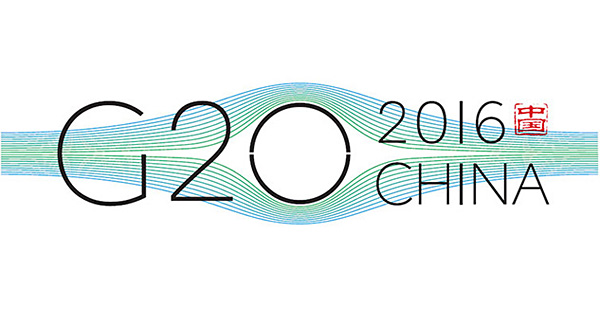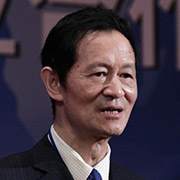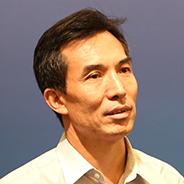A distinct and significant feature of the G20 Hangzhou Summit is the convergence with UN 2030 Agenda for Sustainable Development and the priority for development in the global macro policy framework. While continuing great efforts in global growth and governance by G20 member countries, the Hangzhou Summit will launch a broader framework for North-South and South-South cooperation.

Logo of G20 Hangzhou Summit incorporates the design of a bridge representing a spirit of growth, cooperation, and optimism for the future.

Bridge on the West Lake in Hangzhou
Insufficiency of G20
I contributed an article to G20 Brisbane Summit two years ago. In the article, I appealed for due attention to vast number of poor countries. The article said that “the G20 has partially neglected the poor countries of the world. Although 90% of world GDP is covered by G20 members, the remaining 10% is covered by over 170 countries, mostly small and poor. They represent the vast majority of the world (population) and the most critical and difficult world economic and social issues, such as poverty, food security, climate change, and infrastructures. The G20 does invite small countries to each year’s summit. But they are only a few. Hence, it will be less effective if the G20 wants to address MDG, climate change and food security issues.”
G20 used to be a crisis-responsive mechanism in which big countries played a key role. However, with G20 evolving into a long-term global governance platform, small and less developed countries are also indispensable. The UN has 197 member states while G20 covers only 19+ EU (24 more countries). It will be inappropriate to simply emphasize the share of G20 in world GDP. Brexit has had a strong and persistent impact on world economic landscape although UK accounts for less than 4% of total world GDP. Greece, with less than 2% of EU GDP, also shook the foundation of the Euro area by its debt crisis.
The sharp fall in world oil and commodities prices has added grave difficulties in large numbers of new emerging and developing countries. Global warming threatens, among others, the small island countries in particular. The land-locked countries have also been hit hard by the poor trade performances and trade protection. All the less developed countries suffer from poor infrastructure, inadequate water supply, education and medical services. The strong, sustainable and balanced growth in world economy will be out of question if there is no significant development in those countries.
Challenges for Hangzhou Summit
The IMF has been revising downward the world GDP growth rate once every three months as weakness and vulnerability persist. The most recent edition of its WEO, released in early July after Brexit, showed a sharp deterioration in sub-Sahara countries which used to be one of the fastest growing region in the world. GDP growth rate for this region was estimated at a merger 1.6% for 2016, 1.4 % down from the estimate 3 months ago; and 3.3% for 2017, 0.7 % down. The low-income countries will see 3.8% GDP growth in 2016 (4.5% growth in 2015), only to pick up to 5.1% in 2017. Remember, the UN2030 Agenda envisages an annual growth rate of 7% to attain its 2030 goal. Then the challenge to the Hangzhou Summit is: Can the leaders of the G20, developing countries and international organizations come to a strong and effective commitment to lift the growth rate in those countries?
A key issue is the sharp fall in oil and commodities prices. According to IMF, the world oil price fell by 7.5% in 2014 and 47.2% in 2015, and is expected to fall by 15.5% in 2016, only to rise by 16.4% in 2017. The non-fuel commodities average price level was 4.0% down in 2014 and 17.5% down in 2015, and is projected to fall by 3.8% in 2016 and by 0.6% in 2017.
I also suggested a year ago that the US, Russia and Saudi Arabia, the world largest oil and shale gas producers, also G20 members, sit together at the G20 sideline meetings for stabilizing world oil market. However, the G20 did nothing, only waiting for its own cycle.
Interestingly, there have been an increased capital flows into the commodities markets since the end of 2015. Data by Barclays released on Aug 8 shows that capital inflows into world commodities markets increased by $50 billion since the start of 2016, reaching $235.0 billion by mid-2016, compared to $161.0 billion at the end of 2015. The increase was the largest since 2009, when a three-year boom started in world commodities. Nonetheless, most of the capital has flowed into the oil and gold markets in anticipation of further rises. This also shows that the fluctuations or volatilities of world commodities markets are not only decided by supply-demand factors, but also by capital investment and speculation, as world commodities futures are mostly financial tools, instead of actual needs. Again, the challenge to the Hangzhou Summit is: Can G20 leaders enhance financial governance in world commodities markets?
Two strategies
In order to secure a good start for the development agenda, two strategies, among others, need to be focused on at the Hangzhou Summit.
First, the strategy of world commodities market stabilization. G20 leaders should incorporate this strategy into the broader framework of global financial governance and global finance architecture. World commodities prices, while depending on the supply-demand equilibrium at large, are actually fluctuating with capital moves. Commodities futures trading includes speculation for profit taking. An effective tool to check excessive speculation is managing the margin requirements and relevant strict trading rules. In 2007, speculation was rampant in the world oil futures trading and once sent the price to $147 per barrel. Later, when the margin requirements changed, the oil price nosedived. G20 leaders should agree on the broader strategy for world commodities market stability. The strategy should include both more futures trading governance and additional buffer stocking mechanism, similar to the world food buffer stocks. G20 countries should offer financial assistance and expertise to the mechanism and the developing countries and LDCs should join in the mechanism with good governance and international cooperation.
Second, the strategy of African industrialization. Africa has been one of the fastest-growing regions in the world, and its future lies in the massive industrialization. It is estimated that, if successful, Africa will build up a comprehensive industrial system in a generation and become one of the world’s largest industrialized continents in two generations. Leaders of the G20, AU, UNIDO, WB and other international organizations should launch a collective strategy on African Industrialization with global cooperation. To start with, a strategic study and a comprehensive action plan should be launched at the Hangzhou Summit. By so doing, the Hangzhou Summit will make a landmark contribution to G20 history and start a new pathway to a strong, sustainable and balanced growth in the whole world.

